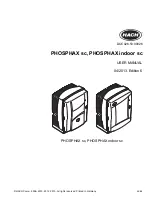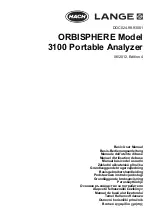
Query
:MACHine{1|2}:SFORmat:CLOCk<N>?
The CLOCk query returns the current clocking mode for a given pod.
Returned Format
[:MACHine{1|2}:SFORmat:CLOCK<N>] <clock_mode><NL>
Example
OUTPUT XXX; ":MACHINE1:SFORMAT:CLOCK2?"
LABel
Command
:MACHine{1|2}:SFORmat:LABel <name>[,<polarity>,
<clock_bits>, <upper_bits>,<lower_bits>
[,<upper_bits>,<lower_bits>]...]
The LABel command allows you to specify polarity and assign channels to
new or existing labels. If the specified label name does not match an existing
label name, a new label will be created.
The order of the pod-specification parameters is significant. The first one
listed will match the highest-numbered pod assigned to the machine you’re
using. Each pod specification after that is assigned to the next highest-
numbered pod. This way the specifications match the left-to-right
descending order of the pods you see on the Format display. Not including
enough pod specifications results in the lowest numbered pod(s) being
assigned a value of zero (all channels excluded). If you include more pod
specifications than there are pods for that machine, the extra ones will be
ignored. However, an error is reported any time more than 22 pod
specifications are listed.
The polarity can be specified at any point after the label name.
Because pods contain 16 channels, the format value for a pod must be
between 0 and 65535 (2
16
−
1). When giving the pod assignment in binary,
each bit will correspond to a single channel. A "1" in a bit position means the
associated channel in that pod is assigned to the label. A "0" in a bit position
means the associated channel in that pod is excluded from the label. Leading
zeroes may be omitted. For example, assigning #B1111001100 is equivalent
to entering "......****..**.." through the touchscreen.
A label can not have a total of more than 32 channels assigned to it.
SFORmat Subsystem
LABel
5–7
Summary of Contents for 16554A
Page 2: ...ii ...
Page 6: ...vi ...
Page 16: ...Contents 10 ...
Page 17: ...Part 1 1 Introduction to Programming 2 Module Level Commands General Information ...
Page 18: ......
Page 19: ...1 Programming the HP 16554A HP 16555A HP 16555D ...
Page 35: ...2 Module Level Commands ...
Page 37: ...Module Level Syntax Diagram Figure 2 1 Module Level Commands 2 3 ...
Page 42: ...2 8 ...
Page 44: ......
Page 45: ...3 MACHine Subsystem ...
Page 47: ...Machine Subsystem Syntax Diagram Figure 3 1 MACHine Subsystem 3 3 ...
Page 56: ...3 12 ...
Page 57: ...4 WLISt Subsystem ...
Page 59: ...WLISt Subsystem Syntax Diagram Figure 4 1 WLISt Subsystem 4 3 ...
Page 71: ...5 SFORmat Subsystem ...
Page 73: ...Figure 5 1 SFORmat Subsystem Syntax Diagram SFORmat Subsystem 5 3 ...
Page 74: ...Figure 5 1 continued SFORmat Subsystem Syntax Diagram continued SFORmat Subsystem 5 4 ...
Page 89: ...6 STRigger STRace Subsystem ...
Page 91: ...Figure 6 1 STRigger Subsystem Syntax Diagram STRigger STRace Subsystem 6 3 ...
Page 111: ...7 SLISt Subsystem ...
Page 113: ...Figure 7 1 SLISt Subsystem Syntax Diagram SLISt Subsystem 7 3 ...
Page 114: ...Figure 7 1 continued SLISt Subsystem Syntax Diagram continued SLISt Subsystem 7 4 ...
Page 115: ...Figure 7 1 continued SLISt Subsystem Syntax Diagram continued SLISt Subsystem 7 5 ...
Page 134: ...7 24 ...
Page 135: ...8 SWAVeform Subsystem ...
Page 137: ...Figure 8 1 SWAVeform Subsystem Syntax Diagram SWAVeform Subsystem 8 3 ...
Page 146: ...8 12 ...
Page 147: ...9 SCHart Subsystem ...
Page 154: ...9 8 ...
Page 155: ...10 COMPare Subsystem ...
Page 157: ...COMPare Subsystem Syntax Diagram Figure 10 1 COMPare Subsystem 10 3 ...
Page 167: ...11 TFORmat Subsystem ...
Page 169: ...TFORmat Subsystem Syntax Diagram Figure 11 1 TFORmat Subsystem 11 3 ...
Page 175: ...12 TTRigger TTRace Subsystem ...
Page 177: ...Figure 12 1 TTRigger Subsystem Syntax Diagram TTRigger TTRace Subsystem 12 3 ...
Page 198: ...12 24 ...
Page 199: ...13 TWAVeform Subsystem ...
Page 201: ...Figure 13 1 TWAVeform Subsystem Syntax Diagram TWAVeform Subsystem 13 3 ...
Page 202: ...Figure 13 1 continued TWAVeform Subsystem Syntax Diagram continued TWAVeform Subsystem 13 4 ...
Page 203: ...Figure 13 1 continued TWAVeform Subsystem Syntax Diagram continued TWAVeform Subsystem 13 5 ...
Page 228: ...13 30 ...
Page 229: ...14 TLISt Subsystem ...
Page 231: ...Figure 14 1 TLISt Subsystem Syntax Diagram TLISt Subsystem 14 3 ...
Page 232: ...Figure 14 1 continued TLISt Subsystem Syntax Diagram continued TLISt Subsystem 14 4 ...
Page 233: ...Figure 14 1 continued TLISt Subsystem Syntax Diagram continued TLISt Subsystem 14 5 ...
Page 252: ...14 24 ...
Page 253: ...15 SYMBol Subsystem ...
Page 255: ...SYMBol Subsystem Syntax Diagram Figure 15 1 SYMBol Subsystem 15 3 ...
Page 261: ...16 SPA Subsystem ...
Page 263: ...Figure 16 1 SPA Subsystem Syntax Diagram SPA Subsystem 16 3 ...
Page 264: ...Figure 16 1 continued SPA Subsystem Syntax Diagram continued SPA Subsystem 16 4 ...
Page 265: ...Figure 16 1 continued SPA Subsystem Syntax Diagram continued SPA Subsystem 16 5 ...
Page 286: ...16 26 ...
Page 287: ...17 DATA and SETup Commands ...
Page 301: ...Part 3 18 Programming Examples Programming Examples ...
Page 302: ......
Page 303: ...18 Programming Examples ...
Page 330: ...Index 6 ...
















































